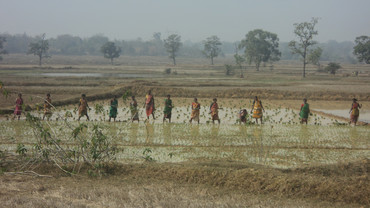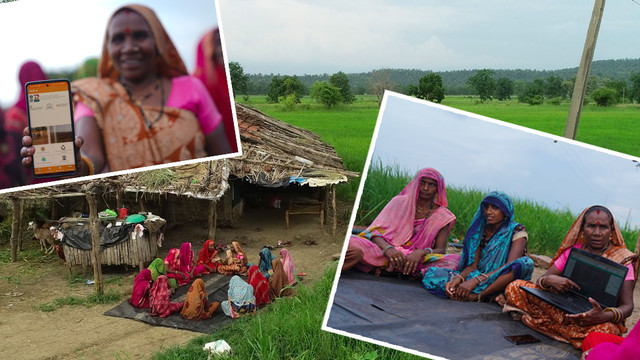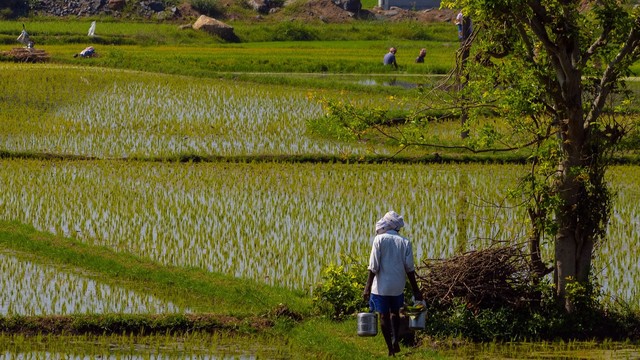Why we need to plug the climate information gap in social protection schemes
Timely flow of climate information under the MGNREGS social protection programme could reliably warn communities of impending crises. Being prepared to respond to hazards can dramatically reduce risks of livelihood loss for India’s rural poor.


New IIED evidence in Rajasthan and Uttar Pradesh shows that few MGNREGS officials or rural households use information about weather and the climate in their decision-making (Photo: Water Alternatives via Flickr, CC BY-NC 2.0)
The Mahatma Gandhi National Rural Employment Guarantee Scheme (MGNREGS) is one of India’s largest social protection programmes. It provides a safety net to poor families by assuring 100 days of unskilled manual wage employment per year to every registered rural household.
Work under the programme includes constructing assets to conserve water and develop land such as farm ponds, check dams and field bunds. These practices can help farmers produce fodder for their animals, and with more water available they can grow double the number of crops on their land – increasing yields significantly.
MGNREGS has been pitted as one of India’s most successful social protection programmes. And the stats hold up well: around 256 million rural workers are registered and benefiting.
But could MGNREGS do even better? Could the high levels of investment – more than US $9 billion per year – deliver even more for India’s rural poor?
Mind the climate information gap
With its huge population and high levels of poverty, climate change is hitting India hard. For MGNREGS to be truly effective, it must support rural households adapt to climate change and build resilience to the impacts.
The programme does take climate change into account – allocating 50 additional days of wage employment in areas affected by hazards such as droughts, floods and cyclones. However, new evidence from IIED from across four districts in Rajasthan and Uttar Pradesh, shows few MGNREGS officials or rural households are using information about current or future weather and the climate in their MGNREGS decisions.
Climate information services are important climate risk management tools that can support rural households to deal with escalating climate risks. They can provide data to make more informed and more robust decisions on climate hazards, including probability and scale.
Effective use of climate information can support people to adjust to potential harm more proactively or take advantage of new opportunities presented by climate change.
Currently, Indian institutions and systems responsible for generating and providing climate information (such as the probability of drought in the upcoming monsoon season) are not formally set up to enable MGNREGS officials and households to use it to inform their wage or asset decisions.
Although traditional and local knowledge is used, it means MGNREGS may not be allocating additional employment days or placing and constructing assets using the best knowledge on likely weather in the upcoming season, or the likely changes in the weather over the coming years and decades due to climate change.
IIED’s research found that there are delays of four to six months in governments officially declaring drought. This leads to delays in sanctioning 50 additional days of wage employment that would help families cope and recover during this critical period.
Aiding short-term response, longer-term planning
If accurate and timely climate information is available, MGNREGS can allocate additional employment days, and in good time. This gives people security, and peace of mind that they will not have to distress migrate, even if their crops are destroyed.
Furthermore, if they have information about imminent drought, farmers can plan ahead – choosing the right crop variety, such as those that can survive water stress. These crops can create enough produce to tide farmers over, even during times of drought.
With longer-term climate information and processes to understand the range of possible future climate change scenarios (for example, increased frequencies of drought, high-intensity rainfall days, cyclones and hailstorms) that may manifest over the next decade, villagers can make more robust decisions on the type, quality and location of assets they will build under MGNREGS – such as assets to prevent soil erosion, for harvesting water and to revive river flows.
A joined up approach
All this calls for a mechanism that supports the smooth and timely flow of climate information. Currently, weather and climate-related data are collected and analysed by a number of agencies that operate under different ministries and organisations. This inhibits coordination of efforts to make this information available to those who need it in time.
A climate information flow and governance mechanism could weave together the different agencies responsible for collection, analysis and forecast. A central agency such as the Ministry of Rural Development, under which MGNREGS is implemented, would be well placed to develop and run such a mechanism.
The mechanism could:
- Help develop drought vulnerability assessments in a user-friendly format that villagers can understand, allowing them to apply the information and blend it with traditional climate knowledge. Ultimately, village communities are responsible for planning and delivery under MGNREGS.
- Help climate information reach the state government and villages in good time. For example, villagers need climate information in April to plan for the additional 50 days and select which crops to grow; state government needs climate information by peak crisis periods (June-August) if it is to declare drought in time for villagers to respond accordingly.
- Support a decision-making framework that will help decide the most appropriate response, depending on the probability of drought. This will help the state government, villagers and MGNREGS functionaries act in a timely manner.
Breaking the cycle of vulnerability
MGNREGS has real potential to help India’s rural poor cope with climate variability by providing early recovery support through wages. This, in turn, can improve access to stronger assets and help develop more diversified crop production systems.
With this support, farmers and farm labourers can maintain or improve their living standards without compromising their long-term prospects when climatic shocks and stresses occur.
Timely climate and weather information along with appropriate decision-making tools at local level – and a central body to lead it – could be instrumental in strengthening MGNREGS’ contribution to building long-term climate resilience.




